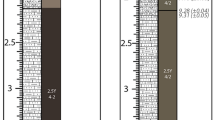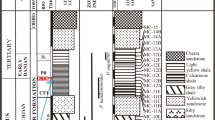Abstract
Cretaceous climate was warmer than today. The Songliao Basin contains one of the most important Late Cretaceous non-marine deposits in China for the research of the paleoenvironment and paleoclimate. This research is based on core samples from the SK1(S) borehole. The strata sampled are the upper part of the Quantou Formation to member 2 of the Nenjiang Formation, where spores, pollen, dinoflagellates, and other microfossils are abundantly preserved. Based on analysis of the spores and pollen fossils from the core samples, the following six fossil assemblage zones have been recognized in ascending order: The Cicatricosisporites-Cyathidites-Pinuspollenites, Schizaeoisporites-Cyathidites-Classopollis, Cyathidites-Schizaeoisporites, Schizaeoisporites-Cyathidites-Proteacidites, Proteacidites-Cyathidites-Dictyotriletes, and the Lythraites-Callistipollenites-Schizaeoisporites zones. The six fossil zones range from the late Cenomanian to early Campanian. The Late Cretaceous dinoflagellate cysts in the Songliao Basin are of high abundance and low diversity. Specific phytoplankton types reflect salinity changes of the Songliao Lake. Paleoecology of the dinoflagellates suggests that sediments of members 2 and 3 of the Yaojia Formation (K2 y 2+3) were deposited in a freshwater environment, whereas members 2 and 3 of the Qingshankou Formation (K2 q 2+3) and members 1 and 2 of the Nenjiang Formation (K2 n 1+2) were deposited in freshwater to brackish water environments. Combined with the paleoecology of dinoflagellates and the palynomorph biozones, valuable information of the paleoclimate was provided. The quantitative analyses of spores and pollen fossils, such as vegetation type, climate type, and humidity type, diversity and dominance, indicate a relatively sub-humid, mid-subtropical paleoclimate, with slight climatic fluctuation and/or temporal change.
Similar content being viewed by others
References
Agasie J M. 1969. Late Cretaceous palynomorphs from northeastern Arizona. Micropaleontology, 15: 13–30
Batten D J. 1984. Palynology, climate and the development of Late Cretaceous floral provinces in the Northern Hemisphere: A review. In: Brenchley P J, ed. Fossils and Climate. Geol J, 11: 127–164
Brideaux W W, McIntyre D J. 1975. Miospores and microplankton from Aptian-Albian rocks along Horton River, District of Mackenzie. Geol Surv Can Bull, 252: 85
Chlonova A F. 1961. Spores and pollen of the upper half of the Upper Cretaceous of the eastern part of the West Siberian Lowland (In Russian). Transactions of the Institute of Geology and Geophysics, Academy of Sciences of the USSR, Siberian Division, Novosibirsk, 7: 139
Choi D K, Park J B. 1987. Palynology of the Jinju Formation (Lower Cretaceous), Waegwan-Daegu and Jinju areas, Korea. J Paleontol Soc, 3: 28–43
Choi D K. 1989. Paleopalynology of the Geoncheonri Formation (Lower Cretaceous), Geoncheon-Ahwa area, Korea. J Paleontol Soc, 5: 1–27
Cornet B, Traverse A. 1975. Palynological contributions to the chronology and stratigraphy of the Hartford Basin in Connecticut and Massachusetts. Geosci Man, 11: 1–23
Couper R A. 1958. British Mesozoic microspores and pollen grains, a systematic and stratigraphic study. Palaeontographica Abt B, 103: 75–179
Deng C L, He H Y, Pan Y X, et al. 2012. Chronology of the terrestrial Upper Cretaceous in the Songliao Basin, northeast Asia. Paleogeogr Paleoclimatol Paleoecol, 385: 44–54
Douglas J N, Masaki M, Makoto I. 2006. Palynology and age of some Cretaceous nonmarine deposits in Mongolia and China. Cretac Res, 27: 241–251
Eckart S. 2010. Pollen and spores from the Tendaguru Beds, Upper Jurassic and Lower Cretaceous of southeast Tanzania: Palynostratigraphical and paleoecological implications. Palynology, 34: 3–42
Feng Z H, Fang W, Zhang J H, et al. 2007. Distribution and significance of C40 alkanes in the extracts of Cretaceous source rocks from the Songliao Basin. Sci China Ser D-Earth Sci, 50: 10–20
Gao R Q. 1988. Petroleum geological significiance of palynological fossils in Cretaceous, Songliao Basin (in Chinese). Petrol Geol Oilfield Devel Daqing, 7: 7–18
Gao R Q, He C Q, Qiao X Y. 1992. Cretaceous Non-marine Dinoflagellates, Chlorophytes and Acritarchs from the Songliao Basin (in Chinese). Nanjing: Nanjing University Press. 68
Gao R Q, Cai X Y. 1997. Field Formation Conditions and Distribution Rules in Songliao Basin (in Chinese). Beijing: Petroleum Industry Press. 319
Gao R Q, Zhao C B, Qiao X Y, et al. 1999. Cretaceous Oil Strata Palynology from Songliao Basin (in Chinese). Beijing: Geological Publishing House. 373
Gao Y F, Wang P J, Wang C S, et al. 2008. Well Site Selecting, Core Profile Characteristics and Distribution of the Special Lithology in CCSD-SKII (in Chinese). Acta Geol Sin, 82: 669–675
He C Q, Song Z C, Zhu Y H. 2009. The Dinoflagellate Fossils in China (in Chinese). Beijing: Science Press. 739
He H Y, Deng C L, Wang P J, et al. 2012. Toward age determination of the termination of the Cretaceous Normal Superchron. Geochem Geophys Geosyst, doi: 10.1029/2011GC003901
Huang, Q H, Chen C R, Wang P Z, et al. 1998. The late Cretaceous bioevolution and anoxic events in the ancient lake in the Songliao Basin (in Chinese). Acta Micropalaeont Sin, 15: 417–425
Huang Q H, Zheng Y L, Yang M J, et al. 1999. Cretaceous Paleoclimte in the Songliao Basin (in Chinese). Acta Micropalaeontol Sin, 16: 95–103
Jarzen D M. 1977. Aquilapollenites and some santalalean genera: A botanical comparison. Grana, 16: 29–39
Jing X, Li S, Xi D P, et al. 2011. Late-Cretaceous Spores and pollen assemblages and paleoclimate record of the Nenjiang Formation in Nong’an, Jilin Province (in Chinese). Acta Micropalaeont Sin, 28: 193–203
Li J G, David J B, Zhang Y Y. 2011. Palynological record from a composite core through Late Cretaceous-early Paleocene deposits in the Songliao Basin, Northeast China and its biostratigraphic implications. Cretac Res, 32: 1–12
Norris G. 1969. Miospores from the Purbeckbeds and marine Upper Jurassic of southern England. Palaeontology, 12: 574–620
Pocock S A J, Jansonius J. 1961. The pollen genus Classopollis Pflug. Micropaleontology, 7: 439–449
Pocock S A J. 1962. Microfloral analysis and age determination of strata at the Jurassic-Cretaceous boundary in the Western Canada Plains. Palaeontographica Abt B, 111: 1–95
Samoilovich S R. 1967. Tentative botanico-geographical sub-division of northern Asia in Late Cretaceous time. Rev Palaeobot Palynol, 2: 127–139
Scott R W, Wan X Q, Wang C S, et al. 2012. Late Cretaceous chronostratigraphy (Turonian-Maastrichtian): SK1 core Songliao Basin, China. Geosci Front, 3: 357–367
Skelton P. 2003. The Cretaceous World. Cambridge: Cambridge University Press. 360
Song Z C, Zheng Y H, Liu J L, et al. 1981. Cretaceous-Tertiary Palynological Assemblages from Jiangsu (in Chinese). Beijing: Geological Publishing House. 268
Song Z C, Li M Y, Zhong L. 1986. Cretaceous and Early Tertiary Sporopollen Assemblages from the Sanshui Basin, Guangdong Province (in Chinese). Beijing: Science Press. 170
Song Z C, Shang Y K. 1999. The Palynology Fossils in China (in Chinese). Beijing: Science Press. 710
Srivastava S K. 1972. Paleoecology of pollen genera Aquilapollenites and Mancicorpus in Maestrichtian deposits of North America. Twenty-fourth International Geological Congress, 7: 111–120
Srivastava S K. 1976. The fossil pollen genus Classopollis. Lethaia, 9: 437–457
Takahashi K. 1974. Palynology of the Upper Aptian Tanohata Formation of the Miyako Group, northeast Japan. Pollen Spores, 16: 535–564
Wan X Q, Chen P J, Wei M J. 2007. The Cretaceous system in China. Acta Geol Sin, 81: 957–983
Wan X Q, Zhao J, Scott R W, et al. 2012. Late Cretaceous Stratigraphy, Songliao Basin, NE China: SK1 cores. Paleogeogr Paleoclimatol Paleoecol, doi: 10.1016/j.palaeo.2012.10.024.
Wang C S, Feng Z Q, Zhang L M, et al. 2012. Cretaceous paleogeography and paleoclimate and the setting of SKI borehole sites in Songliao Basin, northeast China. Paleogeogr Paleoclimatol Paleoecol, doi: 10.1016/j.palaeo.2012.01.030
Wang G D, Cheng R H, Wang P J, et al. 2008. Dolomite formation mechanism in Nenjiang Formation of Songliao Basin (in Chinese). Acta Geol Sin, 82: 65–71
Wang L, Song Z G, Yin Q, et al. 2011. Paleosalinity significance of occurrence and distribution of methyltrimethyltridecyl chromans in the Upper Cretaceous Nenjiang Formation, Songliao Basin, China. Org Geochem, 42: 1411–1419
Wang P J, Xie X A, Mattern F, et al. 2007. The Cretaceous Basin: Volcanogenic succession, sedimentary sequence and tectonic evolution, NE China. Acta Geol Sin, 81: 801–811
Wu H C, Zhang S H, Jiang G. Q, et al. 2009. The floating astronomical time scale for the terrestrial Late Cretaceous Qingshankou Formation from the Songliao Basin of Northeast China and its stratigraphic and paleoclimate implications. Earth Planet Sci Lett, 278: 308–323
Wu H C, Zhang S H, Jiang G Q, et al. 2012. Astrochronology of the Early Turonian-Early Campanian terrestrial succession in the Songliao Basin, northeastern China and its implication. Paleogeogr Paleoclimatol Paleoecol, doi: 10.1016/j.palaeo.2012.09.004
Xi D P, Wan X Q, Feng Z Q, et al. 2011a. Discovery of Late Cretaceous foraminifera in the Songliao Basin: Evidence from SK1 and implications for identifying seawater incursions. Chin Sci Bull, 56: 253–256
Xi D P, Wan X Q, Luba J, et al. 2011b. Late Cretaceous paleoenvironment and lake level fluctuation in the Songliao Basin, northeastern China. Island Arc, 20: 6–22
Xi D P, Li S, Wan X Q, et al. 2012. Late Cretaceous biostratigraphy and paleoenvironmental reconstruction based on non-marine ostracodes from well SK1 (south), Songliao Basin, northeast China. Hydrobiologia, 688: 113–123
Yan J J, Xi D P, Yu T, et al. 2007. Biostratigraphy and paleoenvionmental change of the Lower Nenjiang Formation in the Qingshankou area, Songliao Basin (in Chinese). J Stratigraphy, 31: 296–302
Yi M S, Choi S J, Yun H. 1993. Cretaceous palynomorphs from the Iljik Formation in the Euiseung area, Korea. J Paleontol Soc, 9: 166–179
Author information
Authors and Affiliations
Corresponding author
Rights and permissions
About this article
Cite this article
Zhao, J., Wan, X., Xi, D. et al. Late Cretaceous palynology and paleoclimate change: Evidence from the SK1 (South) core, Songliao Basin, NE China. Sci. China Earth Sci. 57, 2985–2997 (2014). https://doi.org/10.1007/s11430-014-4975-4
Received:
Accepted:
Published:
Issue Date:
DOI: https://doi.org/10.1007/s11430-014-4975-4




